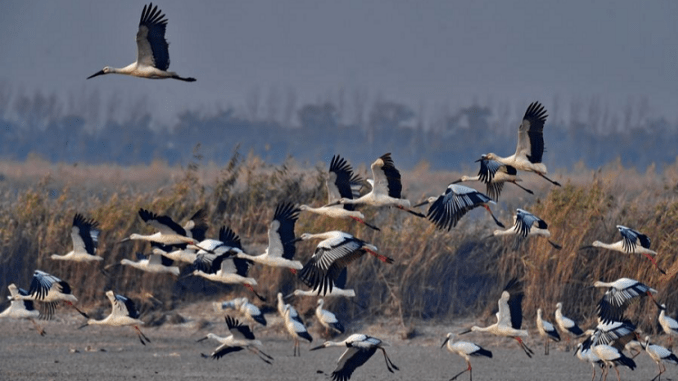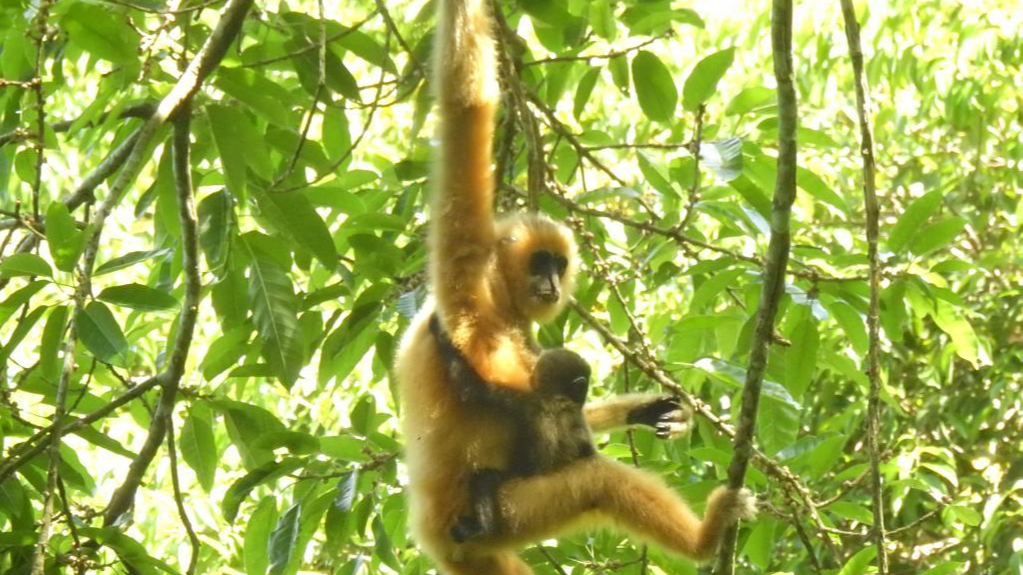
Cover photo: Oriental white storks fly over the Caofeidian wetland in Tangshan, north China’s Hebei Province. /Xinhua
From species to ecosystem: China’s conservation commitment for biodiversity and human well-being.
Jiang Zhigang is professor in Conservation Biology at the University of Chinese Academy of Sciences. His work mainly focuses on inventory, red list assessment, and conservation of animal diversity. The following opinion piece appeared in CGTN.
The Millennium Ecosystem Assessment of the United Nations published in 2005 examined the interconnections between biodiversity, ecosystem services, and human well-being. Biodiversity is vital for producing food, water, timber, and fiber; the diversity of species and genetic variations within those species of biodiversity ensure the resilience and productivity of crops, livestock, and fisheries. Biodiversity maintains nutrient cycling, soil formation, and solar energy fixation in ecosystems. Ecosystems with high biodiversity regulate climate, water quality and pollination, and diverse ecosystems are better at controlling pests, reducing the spread of diseases, and maintaining soil fertility and water purification processes. Biodiversity contributes to recreational, aesthetic, and spiritual benefits for humans.
More than 44,000 species are threatened with the risk of extinction according to the assessment of the International Union for Conservation of Nature (IUCN)’s Red List of Threatened Species. They include 70 percent of cycads, 41 percent of amphibians, 37 percent of sharks and rays, 36 percent of reef corals, 34 percent of conifers, 26 percent of mammals, 21 percent of reptiles, and 12 percent of birds. Habitat destruction, over-harvesting, pollution, and invasive species are the major threats to biodiversity.
Humanity faces significant ecological, economic, and social challenges when biodiversity is threatened. Given its vast and diverse ecosystems, China’s efforts to protect biodiversity are crucial globally.
China is one of the world’s most biodiverse countries and the largest developing country. In 1980, China’s GDP accounted for just about 2 percent of the world’s total, and through fast-paced economic growth, it reached 18.3 percent by 2021. Rapid industrialization, urbanization, pollution, agricultural conversion, and infrastructure development led to significant habitat fragmentation and degradation in the past half century, while overfishing, hunting and illegal wildlife trade directly threaten various species and impact China’s biodiversity. For example, between 2003 and 2013, China lost approximately 9 percent of its natural wetlands, according to the National Forestry and Grassland Administration.
In 2023, China released an updated version of its Red List for Biodiversity in Kunming, which includes 39,330 species of higher plants and 4,767 species of vertebrates. The assessment revealed that 4,088 species of higher plants (10.39 percent) and 1,050 species of vertebrates (22.02 percent) are threatened. It highlighted that the overall trend of declining biodiversity has not been fundamentally reversed. The Red List underscores the continued threats to biodiversity from human activities, habitat loss and overexploitation.
Recognizing the importance of biodiversity, China has implemented initiatives and policies aimed at conservation since the 1980s. It has established a network of protected areas, including nature reserves, national parks, nature parks, world heritage sites and geoparks, now covering about 18 percent of its land area. China has established over 600 wetland nature reserves, around 900 national wetland parks, and 82 Ramsar sites. A Ramsar site is a wetland designated as of international importance under the Ramsar Convention signed in Iran in 1971.
The Chinese Government has enacted laws such as the Law of the People’s Republic of China on the Protection of Wildlife 2022 and the Environmental Protection Law, which provide legal frameworks for biodiversity conservation. China has also drawn up ecological conservation red lines to identify crucial ecological zones, where development is restricted or prohibited to safeguard key ecosystems and species.
Besides, the government has launched ecological restoration programs like the “Great Green Wall” and “Grain for Green,” aiming to restore forests, wetlands and grasslands to combat desertification.
The “Great Green Wall,” also called the Three-North Shelterbelt Forest Program, was initiated in 1978 and aims to create a belt of 35 million hectares of trees by 2050 in northwestern, northern and northeastern China to act as a barrier against desertification. Through targeted conservation programs, China has also been focusing on protecting flagship species like the Hainan gibbon, giant panda, Tibetan antelope and snow leopard.

A Hainan gibbon and its baby in south China’s Hainan Province, May, 2021. /Xinhua
China’s biodiversity conservation has yielded positive outcomes not only for itself but also for global human well-being. Successful conservation efforts have led to the downlisting of the giant panda from “Endangered” to “Vulnerable” on the IUCN’s Red List. The number of critically endangered Hainan gibbons, a close relative of human beings endemic to Hainan, increased from nine in the 1980s to 37 in 2023. Reforestation programs contribute to carbon sequestration and habitat restoration in China; the forest cover in the country has increased from 12 percent of its land area in the 1980s to 24 percent in 2024.
China’s commitment to combating deforestation, mitigating climate change, and enhancing biodiversity and sustainable development are crucial for both ecological balance and human well-being. China’s efforts to protect biodiversity are essential for the country’s environmental health and global biodiversity conservation. However, rapid economic growth often conflicts with conservation goals, requiring more integrated and sustainable development strategies. While significant progress has been made, continuous improvement in enforcement, monitoring and integrating conservation with development is essential. As a global biodiversity hub, China’s biodiversity actions, which emphasize the interconnectedness of ecosystems and the collective responsibility to protect our planet’s biodiversity, have far-reaching implications.
Source: CGTN, May 22, 2024. https://news.cgtn.com/news/2024-05-22/China-s-conservation-commitment-for-biodiversity-and-human-well-being-1tOfRHpNMNW/p.html